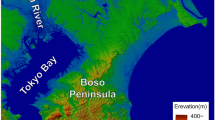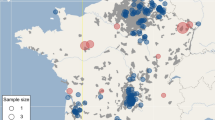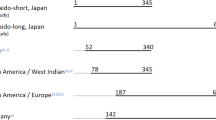Abstract
The common raccoon (Procyon lotor) is endemic to Central and North America, although non-native populations have become established around the world. In Spain, growing evidence of the introduction of raccoons has been reported across the country in the last decade, especially in Central Spain where the largest population is thought to occur. We used mitochondrial and microsatellite DNA data to investigate the genetics of invasive raccoons in Central Spain and to infer: the number of introduction events, the number of founders and the genetic variability of the introduced populations compared to a native population. We found that at least two introduction events have occurred along the Jarama and Henares Rivers in Central Spain, which currently constitute two genetically differentiated subpopulations. In both localities the number of effective founders from a native population was estimated as 2–4 individuals. These newly founded populations have expanded and show evidence of incipient contact and reproduction between them. This may allow for an increase in the genetic variability and adaptive potential of the population(s), possibly increasing the difficulty of controlling this invasive species. Our results reveal the ability to longitudinally monitor the genetics of the raccoon range expansion and emphasize the urgent need to control the pet trade of potentially invasive species.



Similar content being viewed by others
References
Alda F, Inogés J, Alcaraz L, Oria J, Aranda A, Doadrio I (2008) Looking for the Iberian lynx in central Spain: a needle in a haystack? Animal Conserv 11:297–305
Aramburu MJ, Cortés Y, García FJ, González JL, Herrera J, Pérez MJ, Pliego B, Prieto B (2010) Gestión de las poblaciones de mapache (Procyon lotor) en el Parque Regional del Sureste. Unpublished technical report. Comunidad de Madrid, Madrid
Barona J, García-Román L (2005) Presencia de mapache (Procyon lotor) en el Parque Regional del Sureste: distribución actual y abundancia relativa [Presence of raccoons (Procyon lotor) in the Regional Park of Sureste (Madrid): current distribution and relative abundance]. In: Proceeding of the VIII national congress of the Spanish society for the conservation and study of mammals (SECEM), p 15, Huelva, Spain (in Spanish)
Bartoszewicz M (2006) NOBANIS—invasive alien species fact sheet. Procyon lotor. Retrieved from www.nobanis.org on 31 March 2011
Belkhir K, Borsa P, Chikhi L, Raufaste N, Bonhomme F (2004) GENETIX 4.05, logiciel sous Windows™ pour la génétique des populations. Laboratoire Génome, Populations, Interactions, CNRS UMR 5000, Université de Montpellier II, Montpellier
Côté H, Garant D, Robert K, Mainguy J, Pelletier F (2012) Genetic structure and rabies spread potential in raccoons: the role of landscape barriers and sex-biased dispersal. Evol Appl 5:393–404
Cullingham CI, Kyle CJ, Pond BA, White BN (2008) Genetic structure of raccoons in eastern North America based on mtDNA: implications for subspecies designation and rabies disease dynamics. Can J Zool 86:947–958
Cullingham CI, Kyle CJ, Pond BA, Rees EE, White BN (2009) Differential permeability of rivers to raccoon gene flow corresponds to rabies incidence in Ontario, Canada. Mol Ecol 18:43–53
Dalmazzone S (2002) Economic factors affecting the vulnerability to biological invasions. In: Perrings C (ed) The economics of biological invasions. Edward Elgar, Cheltenham, UK, pp 17–30
Dharmarajan G, Beasley JC, Fike JA, Rhodes OE (2009) Population genetic structure of raccoons (Procyon lotor) inhabiting a highly fragmented landscape. Can J Zool 87:814–824
Dlugosch KM, Parker IM (2008) Founding events in species invasions: genetic variation, adaptive evolution, and the role of multiple introductions. Mol Ecol 17:431–449
Falush D, Stephens M, Pritchard JK (2003) Inference of population structure using multilocus genotype data: linked loci and correlated allele frequencies. Genetics 164:1567–1587
Fenner F, Fantini B (1999) Biological control of vertebrate pests: the history of myxomatosis; an experiment in evolution. CABI Publishing, Wallingford
Fitzpatrick BM, Fordyce JA, Niemiller ML, Reynolds RG (2011) What can DNA tell us about biological invasions? Biol Invasions 14:245–253
Funk WC, Garcia TS, Cortina GA, Hill RH (2011) Population genetics of introduced bullfrogs, Rana (Lithobates) catesbeianus, in the Willamette Valley, Oregon, USA. Biol Invasions 13:651–658
García FJ (2007) Gestión de las poblaciones de mapaches (Procyon lotor) en la Comunidad de Madrid [Management of Raccoon populations (Procyon lotor) in the Comunidad Autónoma de Madrid]. In: Proceedings of the VIII National Congress of the Spanish Society for the Conservation and Study of Mammals (SECEM), p 79, Huelva, Spain (in Spanish)
García JT, García FJ, Alda F, González JL, Aramburu MJ, Cortés Y, Prieto B, Pliego B, Pérez M, Herrera J, García-Román L (2012) Recent invasion and reproduction of the Raccoon (Procyon lotor) in Spain. Biol Invasions 14:1305–1310
Gompper ME, Monello RJ, Eggert LS (2011) Genetic variability and viral seroconversion in an outcrossing vertebrate population. Proc R Soc Lond B 278:204–210
Goudet J (1995) FSTAT (version 1.2): a computer program to calculate F-statistics. J Hered 86:485–486
Hedrick PW (2005) Genetics of populations. Jones and Bartlett, Boston, MA
Hill WG (1981) Estimation of effective population size from data on linkage disequilibrium. Genet Res 38:209–216
Hohmann U, Voight S, Andreas U (2002) Raccoons take the offensive. A current assessment. In: Kowarik I, Starfinger U (eds) Biologische invasionen, herausforderung zum Handelsn? Neobiota, pp 191–192
Ikeda T, Asano M, Matoba Y, Abe G (2004) Present status of invasive alien raccoon and its impact in Japan. Glob Environ Res 8:125–131
Kalinowski ST, Muhlfeld CC, Guy CS, Cox B (2010) Founding population size of an aquatic invasive species. Conserv Genet 11:2049–2053
Kauhala K (1996) Introduced carnivores in Europe with special reference to central and northern Europe. Wildl Biol 2:197–204
Kolbe JJ, Glor RE, Schettino LR, Lara AC, Larson A, Losos JB (2004) Genetic variation increases during biological invasion by a Cuban Lizard. Nature 431:177–181
Kuo CH, Janzen FJ (2003) BottleSim: a bottleneck simulation program for long-lived species with overlapping generations. Mol Ecol Notes 3:669–673
Lavergne S, Molofsky J (2007) Increased genetic variation and evolutionary potential drive the success of an invasive grass. Proc Natl Acad Sci USA 104:3883–3888
Lee CE (2002) Evolutionary genetics of invasive species. Trends Ecol Evol 17:386–391
Librado P, Rozas J (2009) DnaSP v5: a software for comprehensive analysis of DNA polymorphism data. Bioinformatics 25:1451–1452
Lizarralde MS, Bailliet G, Poljak S, Fasanella M, Giulivi C (2008) Assessing genetic variation and population structure of invasive North American beaver (Castor canadensis Kuhl, 1820) in Tierra del Fuego (Argentina). Biol Invasions 10:673–683
Luikart G, Ryman N, Tallmon DA, Schwartz MK, Allendorf FW (2010) Estimation of census and effective population sizes: the increasing usefulness of DNA-based approaches. Conserv Genet 11:355–373
Maddison DR, Maddison WP (2000) MacClade 4: Analysis of phylogeny and character evolution. Sinauer Associates, Sunderland, MA
Meirmans PG, Van Tienderen PH (2004) GENOTYPE and GENODIVE: two programs for the analysis of genetic diversity of asexual organisms. Mol Ecol Notes 4:792–794
Monello RJ, Gompper ME (2007) Biotic and abiotic predictors of tick (Dermacentor variabilis) abundance and engorgement on free-ranging raccoons (Procyon lotor). Parasitology 134:2053–2062
Monello RJ, Gompper ME (2009) Relative importance of demographics, locale, and seasonality underlying louse and flea parasitism of raccoons (Procyon lotor). J Parasitol 95:56–62
Monello RJ, Gompper ME (2010) Differential effects of experimental increases in sociality on ectoparasites of free-ranging raccoons. J Anim Ecol 79:602–2609
Monello RJ, Gompper ME (2011) Effects of resource availability and social aggregation on the species richness of raccoon endoparasite infracommunities. Oikos 120:1427–1433
Nei M, Maruyama T, Chakraborty R (1975) The bottleneck effect and genetic variability in populations. Evolution 29:1–10
Park SY, Glaser C, Murray WJ, Kazacos KR, Rowley HA, Fredrick DR, Bass N (2000) Raccoon roundworm (Baylisascaris procyonis) encephalitis: case report and field investigation. Pediatrics 106:E556
Peakall R, Smouse PE (2006) GENALEX 6: genetic analysis in excel. Population genetic software for teaching and research. Mol Ecol Notes 6:288–295
Prange S, Gehrt SD, Wiggers EP (2004) Influences of anthropogenic resources on raccoon (Procyon lotor) movements and spatial distribution. J Mammal 85:483–490
Pritchard JK, Stephens M, Donnelly P (2000) Inference of population structure using multilocus genotype data. Genetics 155:945–959
Pritchard JK, Wen X, Falush D (2009) Documentation for structure software: version 2.3. Department of Human Genetics, University of Chicago
Queller DC, Goodnight KF (1989) Estimating relatedness using genetic markers. Evolution 43:258–275
Rivest P, Bergeron J-M (1981) Density, food habits, and economic importance of raccoons (Procyon lotor) in Quebec agrosystems. Can J Zool 59:1755–1762
Root JJ, Puskas RB, Fischer JW, Swope CB, Neubaum MA, Reeder SA, Piaggio AJ (2009) Landscape genetics of raccoons (Procyon lotor) associated with ridges and valleys of Pennsylvania: implications for oral rabies vaccination programs. Vector-Borne Zoonot 9:583–588
Russello MA, Avery ML, Wright TF (2008) Genetic evidence link invasive monk parakeet populations in the United States to the international pet trade. BMC Evol Biol 8:217
Sakai AK, Allendorf FW, Holt JS, Lodge DM, Molofsky J, With KA, Baughman S, Cabin RJ, Cohen JE, Ellstrand NC, McCauley DE, O’Neil P, Parker IM, Thompson JN, Weller SG (2001) The population biology of invasive species. Annu Rev Ecol Syst 32:305–332
Simberloff D (2009) The role of propagule pressure in biological invasions. Annu Rev Ecol Evol Syst 40:81–102
Siripunkaw C, Kongrit C, Faries KM, Monello RJ, Gompper ME, Eggert LS (2008) Isolation and characterization of polymorphic microsatellite loci in the raccoon (Procyon lotor). Mol Ecol Resour 8:199–201
Smith KF, Behrens M, Schloegel LM, Marano N, Burgiel S, Daszak P (2009) Reducing the risks of the wildlife trade. Science 324:594–595
StatSoft-Inc (2007) STATISTICA (data analysis software system) version 8. www.statsoft.com
Tallmon DA, Koyuk A, Luikart G, Beaumont MA (2008) ONeSAMP: a program to estimate effective population size using approximate Bayesian computation. Mol Ecol Resour 8:299–301
Waples RS (2006) A bias correction for estimates of effective population size based on linkage disequilibrium at unlinked gene loci. Conserv Genet 7:167–184
Waples RS, Do C (2008) LDNe: a program for estimating effective population size from data on linkage disequilibrium. Mol Ecol Resour 8:753–756
Ward RH, Frazier BL, Dew-Jager K, Pääbo S (1991) Extensive mitochondrial diversity within a single Amerindian tribe. Proc Natl Acad Sci USA 88:8720–8724
Warwick C (1991) Conservation of red-eared terrapins Trachemys scripta elegans: threats from international pet and culinary markets. BCG Testudo 3:34–44
Wehtje M, Gompper ME (2011) Effects of an experimentally clumped resource on raccoon (Procyon lotor) home range use. Wildl Biol 17:25–32
Westphal MI, Browne M, MacKinnon K, Noble I (2008) The link between international trade and the global distribution of invasive alien species. Biol Invasions 10:391–398
Acknowledgments
The authors would like to thank M.J. Aramburu, Y. Cortés, L. García-Román, J.L. González, J. Herrera, M. Pérez, B. Pliego, B. Prieto and the staff of the Regional Park Parque Regional del Sureste, Comunidad Autónoma de Madrid, for their help during fieldwork. Capture authorizations were provided by the Comunidad Autónoma de Madrid according to EU laws. We also thank C.I. Cullingham for providing additional information on the geographical distribution of native raccoon haplotypes. Two anonymous referees provided useful suggestions that helped to improve the manuscript. This study was partially funded by the Regional Park Parque Regional del Sureste and the Comunidad Autónoma de Madrid. Sampling and genotyping of Missouri raccoons was supported by grants from the National Science Foundation (DEB-0347609 and DEB-0841654).
Author information
Authors and Affiliations
Corresponding author
Rights and permissions
About this article
Cite this article
Alda, F., Ruiz-López, M.J., García, F.J. et al. Genetic evidence for multiple introduction events of raccoons (Procyon lotor) in Spain. Biol Invasions 15, 687–698 (2013). https://doi.org/10.1007/s10530-012-0318-6
Received:
Accepted:
Published:
Issue Date:
DOI: https://doi.org/10.1007/s10530-012-0318-6




